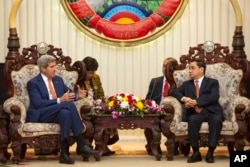U.S. Secretary of State John Kerry arrives in Beijing Tuesday, the last stop of his Asia trip, with territorial disputes in the South China Sea looming as a likely talking point.
Before his visit to China, Kerry also made stopovers in Laos and Cambodia, two countries where Beijing’s influence runs deep and Washington is looking to expand ties.
Analysts say the stops were made in part to prepare for a meeting Washington is hosting for Southeast Asian leaders in Sunnylands California next month. Kerry was also trying to build a consensus over how to respond to China’s recent actions in the South China Sea.
“One of the things that I guess Kerry might get out of the visit is actually a sense of how strongly Laos will probably oppose any decisions on the South China Sea issue,” said Nicholas Thomas, a political scientist at the City University of Hong Kong.
Laos will serve as the rotational chair of the 10-nation Association of Southeast Asian Nations this year and later host a summit that will include leaders from the United States and China.
Members of ASEAN have been working for more than a decade to hammer out a code of conduct for the South China Sea even as Beijing continues to expand its footprint there and assert its claim to all of the hotly contested waters.
Maritime rights
Following a meeting with the Lao prime minister, Kerry told reporters that the landlocked nation wants to see maritime rights respected and avoid a military build-up in the South China Sea.
China’s build-up of artificial islands in the South China Sea that are also suitable as military bases is a big concern for Beijing’s Southeast Asian neighbors. China denies the buildup is for military purposes.
Opinion pieces on Tuesday in Beijing, cast doubt on Kerry’s visit and its ability to sway two “China-friendly countries.” The pieces argued that instead of Washington’s influence, it is Beijing that is gradually gaining momentum in the region.
The party-backed Global Times quoted Shen Shishun, a researcher from the China Institute of International Relations, as saying it is wishful thinking that Kerry’s visit to Cambodia and Laos will provide any incentive to turn against China on the South China Sea issue.
Cambodia backs China
In Cambodia Tuesday, that’s exactly what happened. Cambodia’s Foreign Affairs Minister Hor Namhong echoed Beijing’s position on the dispute to reporters, arguing that ASEAN was not a party to territorial disputes and that disputes should be resolved bilaterally.
In both Laos and Cambodia, Kerry played up growing trade ties. In Phnom Penh, he noted that the United States is the biggest export market of Cambodia, and that both were looking for ways to deepen their trade and investment relationship.
In Laos, Kerry talked about the many areas where the two countries could work together.
“The United States is committed to working very closely with Laos, with the rest of the ASEAN countries. President Obama has invited all of ASEAN to come to California next month. We will have a summit; we will talk about all of these economic issues, how do we improve trade,” Kerry said in remarks to a group of students, members of the Young Southeast Asian Leadership Initiative. “We are currently working with Laos to respond to its request to join the WTO, which will open up the opportunities for trade.”
But making inroads in both countries is not easy, given that they are both small states that are "well and truly within China’s orbit now," Thomas said.
In Laos “it’s about high-levels of Chinese cross-border trade at the sub-national level, it’s about Chinese investment in farms which is helping Laos food security. There are some tensions, certainly with Chinese coming across the border, but the government is certainly supportive of these initiatives,” Thomas said.










